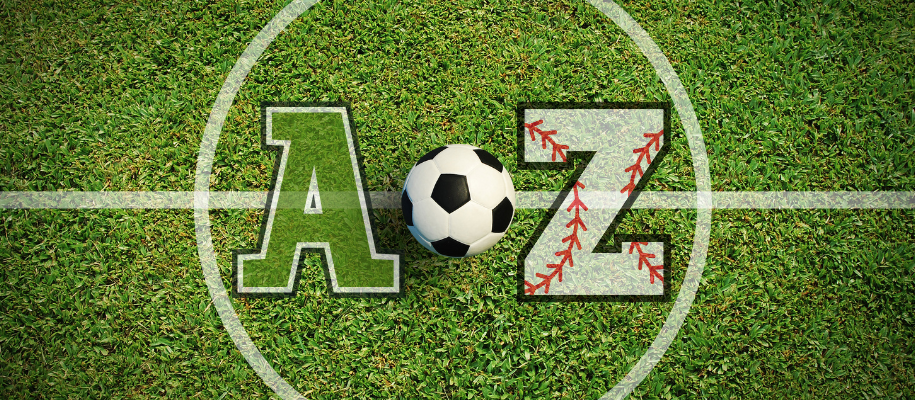Woo, sports! Athletics are a big part of the college experience for student-athletes, fans, and those looking to stay active. So we put together this ultimate athletics glossary to explain all the important (and fun!) stuff you might encounter on a college campus. Whether you want to get recruited, play for fun, or cheer from the sidelines, here are a few college sports terms you should know, tips to help you during the admission process, and a little trivia too!
For the serious student-athlete
If you're planning on playing intercollegiate varsity sports, these are the terms and words you'll likely hear and may need to know to stay up-to-date on your team and the athletics department at your college.
All-American
Outstanding student-athlete recognized by the College Sports Information Directors of America in various collegiate sports. The student-athlete must be nominated by his or her head coach and meet certain academic and athletic criteria, including maintaining a high GPA and playing a certain percentage of games.
Eligibility
Status student-athletes must maintain in order to play Division I and II sports, according to NCAA standards. High school students must register with the NCAA Eligibility Center and meet certain academic requirements regarding core courses, GPA, and standardized test scores in order to compete at D-I and D-II schools. D-III schools maintain their own admission standards and do not require registration. (See "NCAA Divisions I, II, III" below for more info.)
Full ride
Rare athletic scholarship that covers a student-athlete’s tuition and fees, room, board, and textbooks. Offered in six NCAA Division I sports (football; men’s and women’s basketball; and women’s gymnastics, volleyball, and tennis). Full-ride scholarships are not guaranteed for four years and must be renewed year to year by the institution. Full rides are not available at Division II or III schools.
National Association of Intercollegiate Athletics (NAIA) and National Collegiate Athletic Association (NCAA)
The two main governing boards of college athletics control everything from student eligibility to the number of official campus visits a student may make in the recruitment process (see "Recruitment" below).
NCAA Divisions I, II, III
Classifications that indicate the level of competition and amount of money a college devotes to athletics. D-I schools offer the most scholarships to student-athletes in general, but some do not offer them at all (e.g., Ivy League schools). D-II schools offer some athletic scholarships, while D-III schools do not offer any. The NCAA is exerting greater pressure on colleges to make sure that athletes do well in class and on the field. Colleges may lose scholarships or competition eligibility if their players fail to meet the association’s academic standards.
Recruitment
Process by which a college or university woos a student-athlete by letter, phone, invitation to campus, and/or personal visit. The most serious sign of interest is a coach’s visit to a student’s home. But it’s admission departments, not coaches, who admit students. Coaches may make promises they cannot keep, and early sincere enthusiasm may wane as they land other recruits.
Recruitment services
Businesses that compile student-athlete résumé-type profiles and send them to many (sometimes up to 800) colleges for a fee (usually $300–$600). Services guarantee responses from some schools but they don’t guarantee admission to any. Students who are not heavily recruited may find these services effective, as do colleges that don’t have large recruiting budgets. And services are not the same as agents, who charge a commission for obtaining scholarships; agents are not allowed in college athletics.
Redshirt
Student-athletes who attend college, practice with the team, and are present at games but do not compete for one year at their coach’s discretion to further develop their skills and extend their eligibility to play at the collegiate level to five years. A redshirt freshman is technically a sophomore, academically speaking. (Also see “True freshman.”)
Self-recruiting
Process by which the student “markets” themselves to the institution. A few tips for self-recruitment:
- Contact the college admission and athletic departments to ask for information. Write a short but personalized letter to each college coach, stating your athletic and academic accomplishments and a sincere interest in playing for the coach.
- If a coach responds to your letter, suggest a college visit, invite the coach or his or her delegate to visit you, and/or send a short video of yourself in action.
Title IX
1972 law requires institutions to provide federal aid equitably to people of all genders in terms of the number of scholarships, teams, and resources offered.
True freshman
Student-athlete who is in their first year of college both athletically and academically; not to be mistaken for a redshirt freshman, who starts competing during their second year (see “Redshirt”).
Zero Tolerance
A policy in sports organizations that enforces strict rules regarding player conduct—often regarding issues of prejudice, mistreatment of others, misconduct in games and on campus, and more—without exceptions.
Related: What You Need to Know About Athletic Recruitment
For the more casual athlete
Not all students are going to be—or want to be—all-start athletes. Some of us just want to play sports. And that's awesome! Here are the top terms to know for exploring other athletics opportunities on campus.
Club sports
College teams that compete against other schools but are not regulated by the NAIA or NCAA. They are often student-run, hold tryouts and practices, and do not receive funding from the school. In terms of commitment, club sports require less than varsity but more than intramural teams (see “Intramural sports”).
Co-ed/co-recreational
Club and intramural sports teams or leagues in which both males and females can play with and compete against each other. There must be the same number of each gender on a co-rec team, i.e., five male and five female players.
Intramural sports
Recreational leagues and teams for all students, regardless of skill level. Teams are organized within the institution, and participation is not required. Many students join intramurals to meet new people on campus, stay active, and have fun. Common programs include basketball, flag football, soccer, Ultimate Frisbee, kickball, etc.
Related: What's the Difference Between Intramural and Club Sports?
For the super-fan
We can't forget about the sports lovers who are here to support the team from the stands! If you're hanging out with the rest of the school cheering your voice hoars, here are a few things to know and look out for.
Fight song
A school song chanted by fans to cheer on a team. Some college fight songs are over 100 years old; the oldest, Boston College’s “For Boston,” was written in 1885.
March Madness
Nickname for the annual NCAA Division I men’s college basketball tournament held during the month of March. Fans go “mad” with excitement watching teams play in the bracket-style competition. Also called “The Big Dance.”
Tailgate
Social event where fans gather together outside, typically in a parking lot next to a stadium, before a big game. Food and drinks are served from the back of vehicles, yard games are played, and school spirit is required!
Whiteout
An annual game (often for college hockey, basketball, or football) where fans dress in white to show their spirit/solidarity and intimidate the opposing team.
Zamboni
A highlight at hockey games and named after its inventor, Frank Zamboni, this vehicle is used after every game period to clean and smooth the ice. A Zamboni shaves off the top layer to clean up all the marks left behind by skaters and leaves a new layer of water to freeze on top, making rinks sparkle like new. Audience members at college hockey games can enter random drawings to ride along with the Zamboni driver during breaks—something you should add to your bucket list!
Related: List: Colleges and Universities With the Best Teams and Sports Fans
Are you ready for some football (or basketball, or tennis, or whatever your sport may be) now? Whether you're a serious student-athlete, a diehard fan, or somewhere in between, you can enjoy the sport you love on campus—and now you know all the lingo too. Go team!
Find great schools with all your favorite sports to play and watch using our College Lists & Rankings, where you can explore colleges by winning teams, biggest stadiums, most school spirit, and more.








